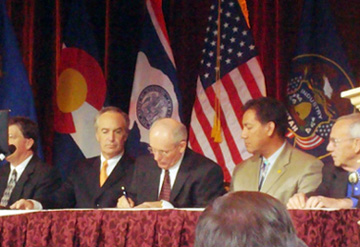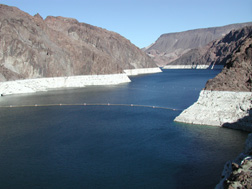Colorado River Shortage Accord Signed
Historic agreement ranked second only to the original 1922 compact
LeRoy W. Hooton, Jr.
December 13, 2007
|
Earlier at the Utah caucus, Water Resources director Dennis Strong described the signing as a “Big Deal,” making the case in his comments that the negotiations were both needed and beneficial to Utah and the other Upper Basin States. “We’re running out of this precious resource, said Strong, “and this agreement protects Utah’s share of the Colorado River.”
The current drought gripping the basin led to the agreement. In 2006 with Lake Powell and Lake Mead levels near 50 percent of capacity, and tree ring history of longer drought periods, past Secretary Norton challenged the states’ to come up with a plan to deal with shortages.
As the Colorado River water masters, both Norton and Kempthorne stressed that negotiations were preferred over litigation. The seven basin states agreed and pursued the path of negotiations. Last December the Shortage Agreement was negotiated by the seven states and in February 2007 the Bureau of Reclamation completed an EIS. The final EIS was published in November 2007. The signing of the Record of Decision finalized the process and put into place the terms of the Shortage Agreement
Secretary Kempthorne said the Record of Decision activates a legal agreement among the basin states that contains a provision in which they firmly commit to address future controversies on the river through consultation and negotiation before initiating any litigation.
The Secretary listed the key points of the agreement as follows:
- New rules for encouraging conservation, including developing new water outside of the basin. Conserved water by lower basin states can now be stored in Lake Mead for future use
- Planning for shortages by identifying who gets water and who looses water
- New rules for Lake Powell and Lake Mead to operate in tandem thereby sharing the risks of drought
- New rules for allocating surpluses
- Preserving flexibility to deal with further challenges such as climate change and persistent drought
|
The globe’s population is expected to reach 9 billion by 2050. By 2040, the U.S. will increase by another 100 million to a total of 400 million. In the Colorado River basin, the Southwest is expected to continue grow at a rate 30 percent greater than the U.S. average, and Las Vegas is the fastest growing city in the nation. While water demands grows, projection models indicate that global warming will produce more droughts in the West, diminishing the supply of water. Clearly, water will continue to be a major challenge, not only in the West, but world-wide.

